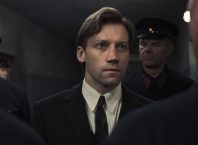By Shlomo Porath
Like last year’s Wall-E, Pixar’s newest film, Up, contains within its first half-hour some of the finest cinema to grace the screen this decade. Here, it is a magical, dialogue-free montage of a life well-lived. This sequence promises all the best qualities past Pixar films have offered, as well as an entirely new realm for these qualities to exist in: reality. The life we see is that of a couple, Carl (Ed Asner) and Ellie Fredricksen . Theirs is a relationship out of a fairytale. They meet as children, become best friends, fall in love, and live happily ever after. We see them work together, dream together and get old together. But real life intrudes on the fairytale, and Ellie passes away, leaving Carl alone, with the realization that fairytales can come true, but that his is behind him.
Up is the tenth feature film from Pixar, but only the second to feature human protagonists. The first, Brad Bird’s The Incredibles, certainly succeeded with its relatable human heroes, but its characters existed in an alternate universe- the 21st century as imagined in the 1960’s. Up exists in a world similar to our own, and as opposed to The Incredibles’ Ayn Rand-esque theme of rejecting mediocrity, this film deals with universalities like mortality and happiness.
In retrospect, this sounds like the most daunting challenge that Pixar and director Peter Docter have set for themselves to date. We know they can create an entirely new world. We know they can breathe life into toys, animals, objects, and monsters. But to make something fantastical and magical within the confines of modern life, with the specter of mortality looming over the proceedings, is a whole new ball-game. I applaud Docter and co. for embracing the challenge, and was elated by how successful they were…for a spell.
After Ellie’s passing, we see Carl trying to live out his remaining years in as painless a way as he thinks he can, by rejecting any connection to the world that took his love from him. Carl won’t leave the home he and Ellie cultivated their whole lives, even when everything around him is destroyed to make way for impersonal sky-scrapers. He is so resolute in his rejection of the world that the first connection he makes results in blood. The altercation in question- Carl hitting a construction worker that touched his mail-box- actually made me gasp. Blood, in a PG-rated animated film! It’s a shocking and daring image, and one that I thought might lead to a deeper, more penetrating look. As it would happen, though, it is so shocking and daring that it all but ends the film’s dealings with reality (the exception is one important scene near the end of the film).
I’ve tried to imagine what a welcome path for this film to have taken would look like, so far without success. But this film reminded me of a complaint I’ve heard about Steven Spielberg- the film is able and willing to take you right to the edge, only to walk you right back down once you get there.
Forced to leave his home for an old age home, Carl decides again to eschew connection with society by literally flying away from it. He chooses to go Up. It’s really a beautiful image- his house, with thousands of brightly colored helium balloons, rising though the streets and sky-scrapers to the sky. It is about as perfect and beautiful an image of escape imaginable. So much so, that it put out of my mind the more mundane but far more compelling ground the film was treading on until that point. The film is on one level aware of the double-edged sword that escape can be, and Carl does eventually come to realize the need in connecting with the world.
Trouble is, Docter and co. don’t seem to agree.
They give Carl a character to connect with: the adorably plucky Russell (Jordan Nagai), a boy-scout who visits Carl trying to get a merit badge for helping the elderly. Russell is stuck on the flying house with Carl and through a very convenient turn of events, becomes Carl’s companion on the journey to fulfill Carl and Ellie’s dream, of living on top of a waterfall in a beautiful south-American jungle. The bulk of the film takes place here, but it’s largely trivial. The film becomes a nice looking (very nice looking in fact – some gorgeous vistas) Hardy Boys adventure in a mystical jungle.
The enthusiastic balloon-faced kid and the cantankerous square-faced old man are now on a wacky and heart-warming adventure with an evil hunter, rare animals, huge caves, unchartered paths, and talking dogs. These are fine fun (especially the talking dogs), but they betray the promise of the first act. Carl does finally decide to connect with the world. In a simple but beautiful scene, Carl realizes the folly of trying to escape from reality by living in the past (or his dreams from the past). But –and this is a big but- Docter and co. have given him only one alternative: the triumvirate of a talking dog, a rare and colorful (like the balloons) animal, and a plucky, adventurous kid. He’s rejecting one kind of escapism for another. Sure, Russell may have a real life with real problems (a less than convincing twist out of the late John Hughes’ Planes, Trains, and Automobiles), but it’s not the life Carl is becoming a part of. Carl is the old side-kick to Russell’s young adventurer (When they come together to fight the villain, it’s on a giant zeppelin over an Amazonian jungle, befitting the ‘Boy’s Tale’ tone). By the way…the villain? Carl’s childhood hero. But the movie has little interest at this point in dealing with the fallibility of heroes. It’s just a plot device the goes nowhere.
The film finally totally recants on it’s opening with its ending. From acknowledging that fairytales end, this movie ends with them living happily ever after. Apparently, the 78 year-old Carl lived to be Russell’s father/grandfather/side-kick figure for ever and ever. Nothing bad will ever happen to them, as long as they stick together. It’s almost as comforting as it is false.
Now, while I was watching it, I did enjoy the film. I loved its beautiful sights and the fine voice acting –Ed Asner is perfect as the curmudgeonly Carl (who incidentally looks like a cross between the later roles of Spencer Tracy and James Whitmore), and Jordan Nagai is surprisingly not annoying as Russell. Christopher Plummer is fine but wasted as Carl’s former hero. Michael Giacchino’s score is quite good, and the adventure, with all its trappings, is perfectly fun. But when trying to piece it all together, the film is maddening in how it achieves greatness, retreats into entertaining goodness (or at least fine-ness), then finally asks you to ignore the true implications of whatever was great, because it’s too prickly and untidy.
Up is a (roughly) 30 minute long masterpiece, which is followed by another hour that tries to convince you it was just kidding.






Comments are closed.